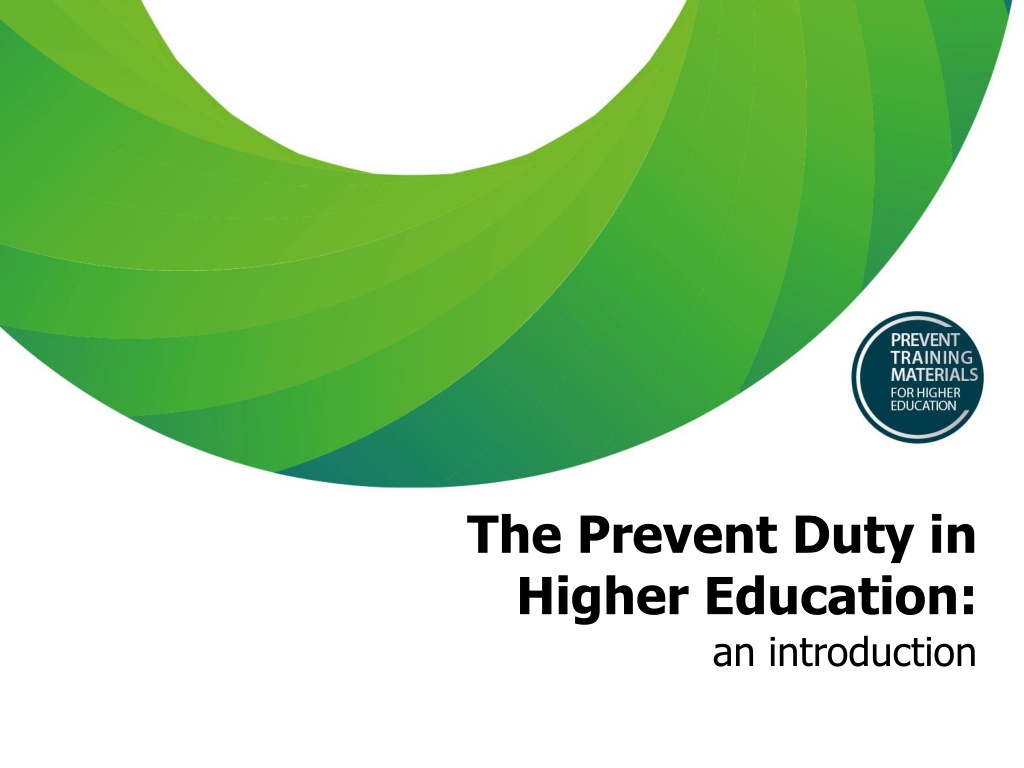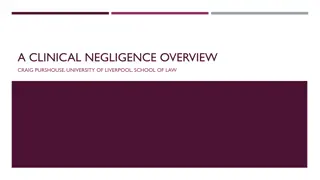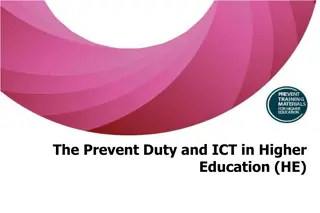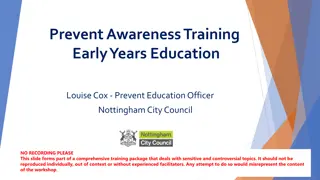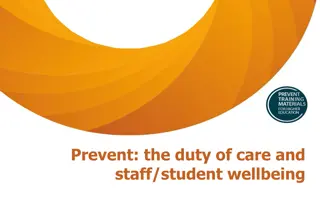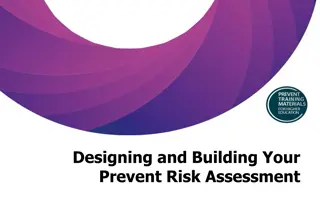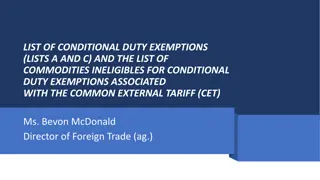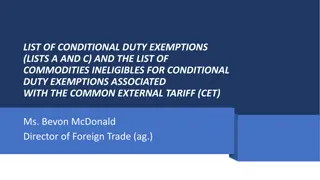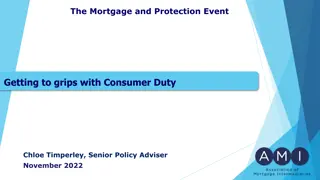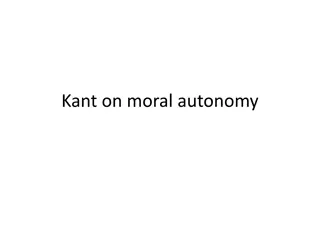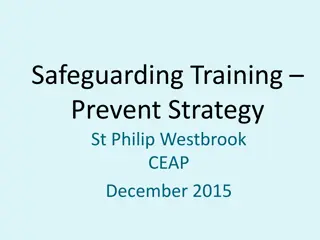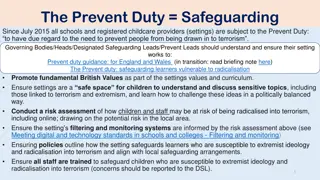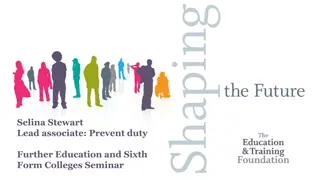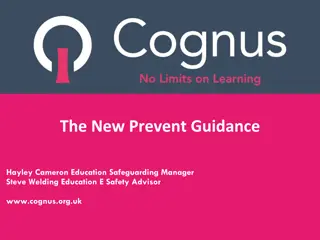Understanding the Prevent Duty in Higher Education
This introduction module provides essential information on the Prevent Duty in higher education, outlining its statutory requirements and objectives. It covers topics such as the Counter-Terrorism and Security Act 2015, the process of radicalization, and strategies to prevent individuals from being drawn into terrorism.
Download Presentation

Please find below an Image/Link to download the presentation.
The content on the website is provided AS IS for your information and personal use only. It may not be sold, licensed, or shared on other websites without obtaining consent from the author. Download presentation by click this link. If you encounter any issues during the download, it is possible that the publisher has removed the file from their server.
E N D
Presentation Transcript
The Prevent Duty in Higher Education: an introduction
Who is this module for? This module is an introductory module intended for staff/other relevant personnel who need to understand the Prevent statutory duty as applicable to higher education, including: Heads of HE providers Heads of Student Services Chairs of Governing Body Chaplains Chief Security Officers Legal Practitioners those with Pastoral Care responsibilities all staff It is good practice for staff with specific safeguarding, leadership or governance responsibilities to gain additional training.
What will the session cover? This session will cover: the Counter-Terrorism and Security Act 2015 what Prevent is the Prevent duty in higher education what must be done the process of radicalisation case studies what Channel is monitoring arrangements accessing further information
Counter-Terrorism and Security Act Passed by parliament in February 2015. Came into force in July 2015 September 2018 for higher education. Section 26 of the Act placed a statutory duty on specified authorities to have: due regard to prevent people from being drawn into terrorism This has become known as the Prevent Duty
Prevent strategy three specific objectives Tackle the causes of radicalisation and respond to the ideological challenge of terrorism. Safeguard and support those most at risk of radicalisation through early intervention, identifying them and offering support. Enable those who have already engaged in terrorism to disengage and rehabilitate. It is the second objective that is of greatest relevance to higher education and its staff and students
What is terrorism? Terrorism Act 2000 In summary terrorism is: the use or threat of action (serious violence against a person, serious damage to property, endangering a person s life, serious risk to the health and safety of the public, serious interference/disruption of an electronic system); designed (i) to influence the government or international governmental organisation; or (ii) to intimidate the public or a section of the public; and made for the purpose of advancing a political, religious, racial or ideological cause. Section 1, Terrorism Act 2000
What does Prevent say about terrorism? Prevent is intended to deal with all forms of terrorism. This is not only about Islamist extremism and so-called Islamist terrorist attacks although it has been perceived as such. Nature and severity of threat varies over time. The statutory guidance describes the current most significant threats but identifies others. From where do you think threats come?
Terrorist threats Listed in alphabetical order: Anarchist extremism Single issue extremism - including environmentalist and animal rights movements that advocate violence Right Wing Extremism Islamist Extremism Incel-related Left Wing Extremism Mixed/Unstable/Unclear ideologies, including fixations on violence Northern Ireland-related terrorism There is also a list of proscribed organisations on GOV.UK
What is extremism? The government has defined extremism as: vocal or active opposition to fundamental British values, including democracy, the rule of law, individual liberty and mutual respect and tolerance of different faiths and beliefs. We also include in our definition of extremism calls for the death of members of our armed forces. Reactionsto this definition?
Holding and expressing views others might find offensive Prevent is not about stopping people holding and expressing views others might find offensive. Holding certain views such as anti-immigration, pro-life, opposition to same sex marriage are all legitimate. It is where there is evidence of vocal or active harassment, intimidation or incitement to violence that there is a risk of people being drawn into terrorism. This is where the need arises for Relevant Higher Education Bodies (RHEBs) to risk assess and manage events where these or similar views may be expressed. Decision in Butt v Secretary of State for the Home Department [2019] EWCA Civ. 256
The process of radicalisation In Prevent, 'Radicalisation' refers to the process by which a person comes to support terrorism and extremist ideologies associated with terrorist group Radicalisation is a process not an event. During that process behaviours as well as opinion are likely to change. These changes can be apparent to the families, friends and work colleagues of the person concerned. (Prevent strategy para, 9.1) It is OK to be radical someone who advocates political or social change through a political party or part of a party to be radical can be progressive. We understand that being 'radical' has many definitions. What we are talking about here is to be radicalised into extremist or terrorist ideology
Preventing radicalisation This is at the core of the Prevent strategy and duty This area of Prevent is based on the premise that people being drawn into radicalisation and recruitment can be identified and then provided with support. (Prevent strategy para. 9.4) In this context Prevent is a safeguarding and welfare issue for staff and students.
The iceberg theory of terrorism Below the surface: Planning Sourcing Fundraising Training Recruitment Radicalisation
Profile 1 Timeline Jack Renshaw 2010 - Joined English Defence League Aged 15 2013 - Became face of BNP Youth 2015 - Attends University 2015 - Spokesperson for National Action - called for Jews to be eradicated and praised Adolf Hitler 2018 - Convicted of inciting racial hatred. He pleaded guilty to preparing an act of terrorism with the intention of beheading Labour MP Rosie Cooper and making a threat to kill a Lancashire police officer Sentenced to Life Imprisonment (Minimum 20yrs)
Profile 2 Roshonara Choudhry Timeline She had been in the final year of a degree. A picture of Labour MP Stephen Timms and a court drawing of Roshonara Choudhry Radicalised online. She dropped out due to finding the university to be anti-Islamic, as they had given an award to the Israeli politician Shimon Peres and ran counter-radicalisation programmes. She attacked Labour MP Stephen Timms because of his support for the Iraq war. She ordered her defence team not to challenge the prosecution's case because she did not recognise the jurisdiction of the British court. She was jailed for life.
Factors that contribute to vulnerability (Cole) Some examples of what vulnerability might look like are: Change in behaviour and/or appearance as a result of new influences Possession of literature relating to extreme views Experience of poverty, disadvantage or social exclusion Identity confusion Extremist influences Conflict with family over religious beliefs and/or lifestyle choices/extreme views An event or series of traumatic events (personal, global or national) Victim or witness to race or religious hate crime Recent political or religious conversion Pressure from peers associated with extremism Rejected by faith, peer, social group or family Underachievement
HE-specific duty and guidance The duty applies to all Relevant Higher Education Bodies (RHEBs) and compliance is monitored by the OfS. RHEBs are listed in Schedule 6 of the Act and include: providers listed in s11 Higher Education Act 2004, namely: those registered with the OfS; those designated for student support by the Secretary of State (e.g. for the purposes of teach out ); all the autonomous colleges, schools and halls of the Universities of Cambridge, Durham and Oxford. private providers that are not registered but have more than 250 higher education students (excluding distance learning). Ultimate responsibility for implementing the duty lies with the governing body or the proprietor.
Expectations Compliance requires that properly thought-out and proportionate procedures and policies are in place. Compliance will only be achieved if these are properly followed, actively applied, and reviewed appropriately. Guidance not prescriptive providers will need to make their own decisions on how to implement. Requirement to undertake and maintain up to date Prevent risk assessments. Risks of students and staff being drawn into terrorism will vary geographical location, profile of student body. Where a risk is identified, a Prevent action plan that is proportionate to the risk.
What Prevent is not about Snooping on our students. Interfering with academic freedom and freedom of expression (this is specifically protected in the Act). Ignoring legal responsibilities relating to equality and diversity and promoting good campus relations. Preventing research and teaching on sensitive topics. Ignoring our responsibilities around confidentiality and data protection. These are some of the common misconceptions that make Prevent a contentious issue.
Prevent duty expectations Risk assessment Partnerships Action Plans, including policies and procedures for management of events and speakers Staff training Welfare and Pastoral Care IT Policies Student Unions and Societies
Prevent duty expectations (continued) A Prevent lead and either a steering group or an existing Prevent committee. An appropriate programme of awareness training of Prevent. Procedures on pastoral care of students that reference Prevent. Building capability of staff to recognise vulnerable individuals and what to do in such circumstances, using internal cause for concern procedures. Information sharing agreements internal and external. Effective consultation with students, students unions (or student associations/representatives) and student societies. Active senior level engagement with other partners.
External speakers and events Applies to all external speakers. Applies to events off-campus that are affiliated, branded or funded by the institution. Applies to events on campus organised by anyone external to the institution. This includes online events. A process of risk assessment. Mitigation of risks vs cancellation. Measures to challenge extremist views that risk people being drawn into terrorism. Awareness of providing physical security.
Policies on pastoral care This is central to implementation of the duty in higher education. RHEBs have a long history of providing pastoral care and paying regard to the welfare of their students. RHEBs have a duty of care to students and staff especially for those who might be vulnerable , including those who might be vulnerable to being drawn towards terrorism. Prevent duty guidance expects pastoral care to be available to all students. RHEBs will want to ensure that relevant cause for concern procedures incorporate advice on what to do in cases where a student demonstrates vulnerability to being drawn into terrorism. Ensuring appropriate chaplaincy support and management of faith-related spaces where appropriate.
Case studies We have stressed that Prevent is about protecting vulnerable people from being drawn into terrorism. If this is to be achieved, staff will need to make decisions about individual students. Staff must not take hasty decisions or take inappropriate action. Let s look at a number of scenarios
Case study 1 What would you do? A student has converted to Islam. He has no family ties to and no previous understanding of the faith and seems to be learning about it from the internet .
Case study 2 What would you do? A student has asked his chemistry lecturer how to make anthrax. Other students in the class laughed at him and the individual stood up, aggressively responding; you don t even know me! and left the class .
Case study 3 What would you do? A student has started to control use of the prayer room, only allowing those who share similar views and values to enter and making others feel uncomfortable and unwelcome .
Case study 4 What would you do? During an organised and peaceful demonstration on campus against the Iraq war, one student starts shouting and accusing everyone of being complacent and as guilty as the government . It is clear that he is making his peers feel very uncomfortable and has deviated from the message that the campaign is trying to achieve...
Case study 5 What would you do? A student has showed his counsellor violent videos of beheadings in Syria and seems to be obsessed with them .
Its a real case All five scenarios relate to a single case an individual student who was subsequently convicted of preparing terrorist acts involving a shopping centre in Bristol. How might this have been avoided?
A procedure for advice, support, intervention and referral RHEBs should have in place a procedure for staff to raise concerns about a student (including matters relating to radicalisation) For many providers, student welfare department, student services, etc. is likely to be the responsible department. Concerns may come from a range of sources such as other students, academic or personal tutors, student services staff, residential and accommodation staff. In the case of concerns around Prevent, it is important that the referral is made to the designated person as identified in the procedure. The case study shows the importance of connecting what may appear to be isolated events. E-learning on how to make robust, informed and proportionate Prevent referrals is available online and relevant to the designated Prevent/Safeguarding lead.
Making referrals to Prevent All RHEBs will have in place a system usually requiring that referrals are made through a Single Point of Contact (SPOC). This is important to ensure that there is a suitable internal assessment before proceeding. There have been unfortunate cases where inappropriate referrals have been made and reported in the media. Initial concerns should be shared internally within the organisation utilising existing safeguarding procedures. The SPOC can then make any necessary enquiries and if appropriate share the concern with external partners. During this information gathering/sharing stage (as with other safeguarding issues), it is not necessary to obtain the individual s consent. If a Prevent referral is made to external partners, it is good practice to do so with the individual s acknowledgement / agreement, however, consent is not required. Referrals to Channel will not be revealed through reports obtained from the DBS. Members of your Prevent team will be able to give advice in this area.
What is Channel? A programme that focuses on providing support at an early stage to people identified as vulnerable to being drawn into terrorism. It ensures that vulnerable young people and adults receive support before they become involved in terrorist related activity. A multi-agency approach whose success depends on cooperation between agencies. Participation in the programme is voluntary. Works best when the individuals and their families fully engage with the programme.
The Channel process All referrals are screened to ensure that there is a specific risk and that they are not misinformed or malicious. All local authorities must establish Channel panels and must chair them. As well as the local authority chair, a police representative will be present. There is a duty on all partners identified in the Act to co-operate with panels this includes RHEBs. The composition of any panel will depend on the nature of the referral (RHEB representatives will be included in relevant cases). E-learning on Channel, its objectives and roles and responsibilities is available online. This includes information for those who have made a referral and are asked to attend a panel discussion.
Monitoring for compliance For RHEBs in England this is the (OfS), in Wales this is HEFCW and there are different arrangements for Scotland. There is an ongoing requirement for governing bodies or proprietors to submit an annual report demonstrating evidence of ongoing engagement and active implementation of the Prevent duty to OfS. These reports should include data (on training, referrals to Channel, higher risk events referred for senior institutional approval, etc.) Prevent reviews meeting of individual providers will take place where there are particular circumstances, risk indicators or as part of random dip sampling. RHEBs should contact OfS (England) or HEFCW (Wales) to discuss any serious incidents relating to their Prevent duty responsibilities. RHEBs in Scotland should contact local multi-agency CONTEST groups and the national Prevent and CONTEST governance structures for support.
Further information and training Prevent awareness training for all staff is available: https://www.elearning.prevent.homeoffice.gov.uk/edu/screen1.html Prevent training can be accessed through HE/FE Regional Prevent Coordinators: www.gov.uk/guidance/regional-further-education-fe-and-higher-education-he-prevent- coordinators
